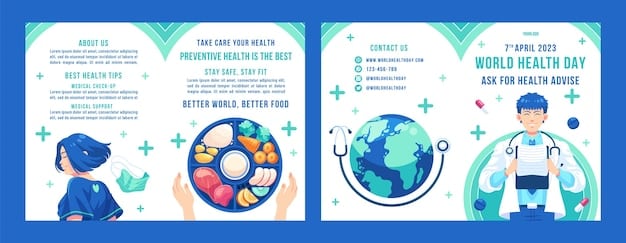Single Dad’s Guide: Affordable Healthcare for Children in 2025

Navigating affordable healthcare options for your children as a single dad in 2025 requires understanding available resources, exploring government programs, and utilizing cost-effective strategies to ensure your children have access to quality medical care without straining your finances.
Being a single dad’s guide to affordable healthcare options for your children in 2025 involves unique challenges. This guide provides a comprehensive overview of how to secure quality healthcare for your kids without breaking the bank.
Understanding the Healthcare Landscape in 2025
The healthcare landscape is constantly evolving, and in 2025, several factors will continue to influence the affordability and accessibility of healthcare. Understanding these factors is crucial for single dads navigating the system.
Staying informed about changes in healthcare policies and insurance options can help you make the best decisions for your children’s health while managing your budget effectively.
Key Factors Influencing Healthcare Costs
Several factors contribute to the overall cost of healthcare. These include advancements in medical technology, pharmaceutical prices, and changes in insurance regulations.
The Role of Healthcare Reform
Healthcare reform initiatives can have a significant impact on the availability and affordability of insurance plans. Being aware of these reforms can help you anticipate changes and plan accordingly.
- Research current healthcare legislation to understand potential impacts.
- Stay updated on changes in insurance regulations and subsidies.
- Consult with healthcare professionals to understand emerging trends and technologies.
By staying informed about the evolving healthcare landscape, you can better navigate the system and make informed decisions about your children’s healthcare needs. Keeping abreast of policy changes and cost drivers ensures you can adapt your strategies for affordable coverage.
Government Healthcare Programs for Children
Government healthcare programs offer vital support for children, especially those in single-parent households. Understanding the eligibility criteria and benefits of these programs is essential.
These programs are designed to provide access to quality healthcare services, ensuring that children receive the medical attention they need without imposing undue financial burdens on their families.

Medicaid and CHIP
Medicaid and the Children’s Health Insurance Program (CHIP) are two key government programs providing healthcare coverage to children from low-income families. Eligibility requirements vary by state.
How to Apply
The application process for Medicaid and CHIP typically involves submitting an application online or in person, along with documentation of income and residency. It is important to gather all necessary information before applying.
- Check the specific income eligibility requirements for your state.
- Gather documents proving income, residency, and family size.
- Apply online or in person through the appropriate state agency.
Utilizing government healthcare programs can significantly reduce the financial strain of healthcare costs. By understanding the eligibility criteria and navigating the application process effectively, you can ensure your children receive comprehensive healthcare coverage.
Private Health Insurance Options
Private health insurance offers a range of options for covering your children’s healthcare needs. These plans can vary in terms of coverage, premiums, and out-of-pocket expenses.
Exploring different private insurance plans and understanding their benefits and limitations can help you choose the best option for your family’s situation.
Comparing Plans
When comparing private health insurance plans, consider factors such as monthly premiums, deductibles, co-pays, and the scope of coverage. It’s crucial to weigh the costs against the benefits.
Affordable Care Act (ACA) Marketplaces
The ACA marketplaces provide a platform for comparing and purchasing private health insurance plans. Subsidies may be available to help lower the cost of premiums for eligible families.
- Compare different plans based on premiums, deductibles, and coverage.
- Check eligibility for premium subsidies through the ACA marketplace.
- Consider a high-deductible health plan with a Health Savings Account (HSA).
Choosing the right private health insurance plan involves balancing cost and coverage. By carefully comparing plans and understanding the potential for subsidies, you can find an affordable option that meets your children’s healthcare needs.
Strategies for Managing Healthcare Costs
Managing healthcare costs effectively involves employing strategies that minimize expenses while ensuring access to quality care. These strategies can help you stay within your budget and avoid unnecessary financial strain.
From preventive measures to cost-conscious choices, there are several ways to make healthcare more affordable for your family.

Preventive Care
Focusing on preventive care, such as regular check-ups and vaccinations, can help identify and address health issues early, potentially avoiding costly treatments down the line.
Telemedicine
Telemedicine offers a convenient and often more affordable alternative to in-person doctor visits. Many insurance plans now cover telemedicine services.
- Prioritize preventive care to catch health issues early.
- Utilize telemedicine for routine consultations and follow-ups.
- Negotiate medical bills and explore payment plans with healthcare providers.
Implementing these cost-saving strategies can significantly reduce your healthcare expenses. By prioritizing preventive care and making informed choices about treatment options, you can maintain your children’s health without overspending.
Non-Profit and Community Resources
Non-profit organizations and community resources can provide valuable support in accessing affordable healthcare. These resources often offer services such as free clinics, discounted medications, and financial assistance.
Exploring these options can supplement your healthcare coverage and provide additional support for your family’s needs.
Free Clinics
Free clinics offer medical services to low-income individuals and families who may not have insurance coverage. These clinics are staffed by volunteer healthcare professionals.
Discounted Medications
Several programs offer discounted medications to eligible individuals. These programs can help lower the cost of prescription drugs and make them more accessible.
- Research local free clinics and their eligibility requirements.
- Explore programs offering discounted medications.
- Contact local social service agencies for assistance.
Leveraging non-profit and community resources can provide additional avenues for accessing affordable healthcare. These resources can help bridge the gap and ensure your children receive the medical care they need, regardless of your financial situation.
Financial Planning for Healthcare
Financial planning is crucial for managing healthcare costs and ensuring that your family’s healthcare needs are met. Developing a budget and setting aside funds for medical expenses can provide financial security.
Strategic financial planning can help you navigate the complexities of healthcare costs and make informed decisions about insurance coverage and treatment options.
Creating a Healthcare Budget
Allocate funds in your budget specifically for healthcare expenses, including premiums, deductibles, and out-of-pocket costs. This can help you avoid unexpected financial burdens.
Health Savings Accounts (HSAs)
If you have a high-deductible health plan, consider opening a Health Savings Account (HSA). HSAs allow you to save pre-tax money for healthcare expenses.
- Create a detailed healthcare budget to track expenses.
- Consider a Health Savings Account (HSA) for tax-advantaged savings.
- Consult with a financial advisor for personalized planning.
Effective financial planning is essential for managing healthcare costs and ensuring your family’s financial well-being. By creating a budget, utilizing tax-advantaged savings accounts, and seeking professional advice, you can navigate the complexities of healthcare financing and secure your children’s health.
| Key Point | Brief Description |
|---|---|
| 🏥 Government Programs | Medicaid and CHIP offer coverage for eligible children. |
| 💰 Private Insurance | ACA marketplaces provide options with potential subsidies. |
| ⚕️ Preventive Care | Regular check-ups and vaccinations can prevent costly issues. |
| 🤝 Community Resources | Free clinics and medication programs offer additional support. |
Frequently Asked Questions
▼
CHIP provides low-cost health coverage to children in families who earn too much to qualify for Medicaid but cannot afford private insurance. It covers medical care, dental, and vision care.
▼
The Affordable Care Act (ACA) marketplaces offer a range of private plans. Subsidies are available based on income to help lower premiums, making insurance more accessible.
▼
An HSA is a tax-advantaged savings account that can be used to pay for qualified medical expenses. It is available to individuals with high-deductible health insurance plans, offering a way to save pre-tax dollars.
▼
Yes, many pharmaceutical companies and non-profit organizations offer patient assistance programs that provide discounted or free medications to eligible individuals. Check online for programs that match your needs.
▼
Telemedicine offers remote consultations with healthcare providers, reducing the need for in-person visits. It saves time and money on travel, and often has lower consultation fees than traditional office visits.
Conclusion
Securing affordable healthcare for your children as a single dad requires proactive planning and informed decision-making. By understanding your options, utilizing available resources, and managing your finances effectively, you can ensure your children receive the care they need without compromising your financial stability. Staying informed and adaptable will be key to navigating the healthcare landscape in 2025 and beyond.





